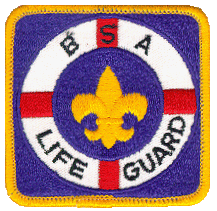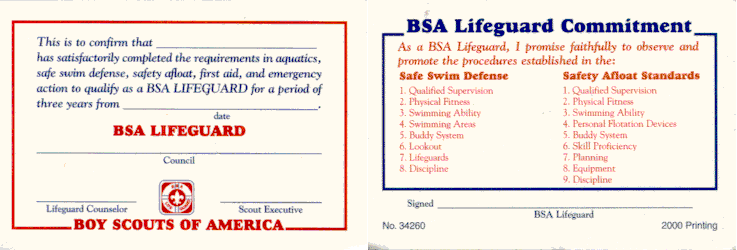|


BSA Lifeguard

SWIM TRUNKS EMBLEM
The BSA Lifeguard Patch is NOT worn on the Uniform.
It is worn on the right side of the swim trunks.
Revisions to these requirements,
which became effective on January 1, 2003,
are shown in Bold Underlined print, similar to this paragraph.
Deletions are shown struck
through in red italics, like this text.
Unchanged text is shown like this.
To see the current requirements with no
highlighting of the changes,
Click Here
The application for BSA Lifeguard can be downloaded from BSA's web site
by clicking here.
- AGE REQUIREMENT
To enroll in the BSA Lifeguard course you must be at least 14
years of age or have completed the eighth grade.
- PREREQUISITES
To enroll in the BSA Lifeguard course, you must
- Swim 400 yards. Jump feetfirst into water over your head and swim
continuously for 400 yards in a strong manner. The 400 yards shall
consist of a minimum of 50 yards of elementary backstroke; 50 yards of
breaststroke; 50 yards of front crawl or trudgen; and 50 yards of
sidestroke.
- Surface dive. Perform both a feet-first and a
head-first (tuck or pike) surface dive in 8 to
10 feet of water and recover a 10-pound weight on
both dives
each dive.
- Float. Demonstrate the ability to rest by floating.
- Dive. Perform a long, shallow dive.
- AQUATICS SKILLS
Perform
Demonstrate each of the following
aquatic
aquatics skills:
- Perform a long, shallow dive into deep water and swim an
approach stroke 25 yards in 20 seconds or less
using an approach stroke.
- Throw a line for accuracy 10 yards, three times in one minute. The
line may be weighted, unweighted, or attached to a ring
buoy.
- Perform a rescue of a swimmer using a watercraft common to your
area. Explain how other watercraft can be used to perform a rescue.
Explain the advantages and disadvantages of different craft in making
rescues.
- Perform each of the following rescues with the aid of a rescue
tube:
- Perform a swimming extension rescue. Using a front
approach, swim with the rescue tube 15 yards to a
conscious, passive victim
distressed swimmer; extend the rescue tube to the
victim; have the victim grasp the
rescue tube it; and tow the
victim back to the starting point in the water.
Using a front approach, swim
with the rescue tube 15 yards to a conscious, passive victim; wrap
the tube around the victim; and tow the victim back to the starting
point in the water. Repeat using the rear approach.
3. Perform an active drowning victim rear
rescue. Using a rear approach, swim with the rescue tube 15
yards to a conscious/active but not struggling victim; Place the
victim on the tube by using a "scooping technique and tow the victim
back to the starting point.- Perform an passive drowning victim rear rescue. Using a
rear approach, swim with the rescue tube 15 yards to face down
victim; squeeze the rescue tube between your chest and the victim's
back, role the victim face up and tow the victim back to the
starting point in the water.
- Perform an passive drowning victim front rescue. Approach
a face-down, unconscious victim from the front; Reaching across the
rescue tube, grasp the victim's wrist and rotate the victim into the
rescue tube. Clamp the victim to the tube with your other arm and
tow the victim back to the starting point.
- Perform a submerged victim rescue. Approach until you are
over the victim and do a feet-first surface dive. Using the rescue
tube between your chest and the victim's back, move the victim to
the starting point.
- Perform a swimming rescue of a distressed or active victim
using a flotation aid other than a rescue tube. Demonstrate an
appropriate entry and approach stroke for 15 yards and the tow
the victim to the starting point.
e. Perform
a stride jump into water at least 9 feet deep; swim 15 yards to an
unconscious victim; use a front surface approach; position the victim
for a wrist tow; and use a wrist tow to return the victim to the
starting point in the water.f. Perform
a long shallow dive into water at least 9 feet deep; swim 15 yards to
beyond the rear of
the victim; position the victim in either a single- or double-armpit
tow; and tow the victim to the starting point in the water.g. Jump feetfirst
Perform a compact jump into water at least 9 feet deep;
using a rear approach swim 15 yards to an active victim; contact the
victim and level him or her
the victim using a single- or double-armpit tow;
position the victim in a cross-chest carry; and return to the starting
point in the water.h. Perform
the following defenses and escapes:
One- and two-hand block
2 Wrist-grip escape3.
Rear head-hold escape4.
Front head-hold escape
i. Remove
the victim from the water using each of the following techniques,
in the appropriate circumstances:
Pack-strap carry
2. Lift from
deep the water
assisted by a second lifeguard
using a backboard and two lifeguards3. Shallow water
Walking assist4. Beach
drag
j. Perform
an ease-in entry into
in shallow water and approach a victim who is facedown
on the surface and simulating a spinal injury. Turn the victim to a
faceup position and support the victim at the surface.k. Perform
an ease-in entry in deep water and approach a victim who is floating
facedown on the surface and simulating a spinal injury. With a rescue
tube, turn the victim to a faceup position and, maintaining contact,
swim with the victim to a corner of the pool or the shallow end of the
pool. Repeat without a rescue tube.l. As a
team member, participate in a back-boarding procedure in shallow
water.m. Perform the requirements
found in the Snorkeling, BSA, award.
Demonstrate the proper use of mask, snorkel, and
fins.
- FIRST AID AND CPR
- Show evidence of the ability to perform the skills and a knowledge
of
the subjects covered in the First
Aid merit badge basic first aid.
- Show a knowledge of the procedures
for treating a near drowning,
for the universal precautions for bloodborne pathogens,
of personal health protection, and of aquatics-related first aid.
Have
Hold current certification in basic cardiopulmonary
resuscitation (CPR) from the American Heart Association, the American
Red Cross, or the National Safety Council.
- EXAMINATION
- Demonstrate an understanding of aquatics program and emergency
management skills by correctly answering 80 percent of the questions
in a written or oral exam on theory and knowledge (
the
standard BSA Lifeguard examination).
- SUPERVISED LIFEGUARDING
PRACTICAL EXPERIENCE
a. Explain how to guard each of the following activities:
Recreational swim (general swim)Unit swimInstructional swimWatercraft activity Special event
b. Serve as a
lifeguard, under supervision, for at least two swimming activities (2 to
3 hours total).
BSA LIFEGUARD TRAINING PROCEDURE
- Only.those persons currently certified as BSA Aquatics
Instructor or as BSA Lifeguard Counselor may train the
completion of BSA Lifeguard requirements
- Training as BSA Lifeguard is valid for
3 years from the date of application.
- All requirements must be met - no substitutions or omissions are
permitted.
- The completed application is sent to the local council service
center where BSA Lifeguard emblems may be purchased.
- To qualify for BSA Lifeguard, the candidate must complete the BSA
Lifeguard course consisting of a minimum of 30 hours under the direction
of either a BSA Lifeguard Counselor or a BSA Aquatics Instructor. The
course for the BSA Lifeguard is in the BSA Lifeguard Counselor Guide.
BSA LIFEGUARD RETRAINING
To be retrained as BSA Lifeguard, a person who previously has been
trained can complete the regular BSA Lifeguard course, passing each of the
requirements. Those whose BSA Lifeguard training is current or has expired
within the past 12 months can be retrained by demonstrating a current
knowledge of and ability to perform the skills necessary to fulfill BSA
Lifeguard requirements. It is not necessary to retake the BSA Lifeguard
course.
In addition to the Patch shown at
the top of this page, a wallet card ( No. 34260) shown below, is
available.
 |